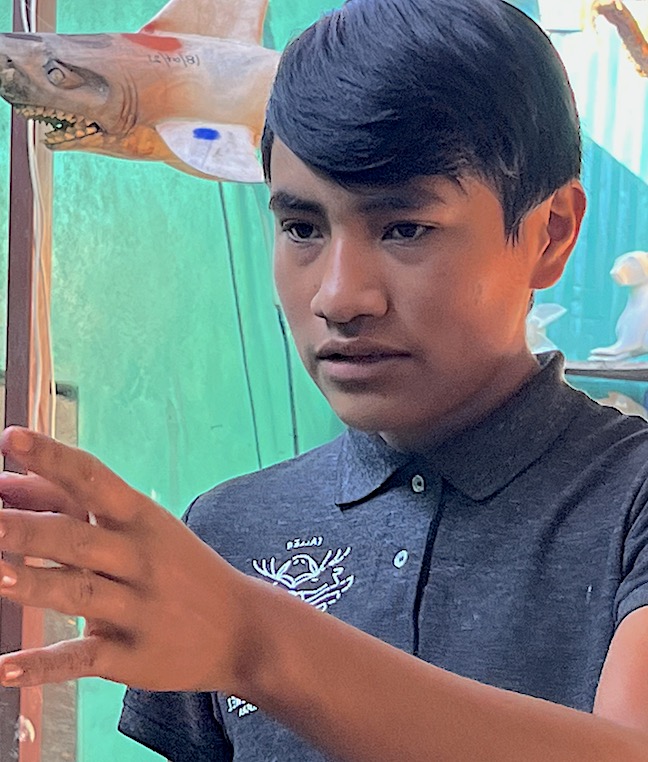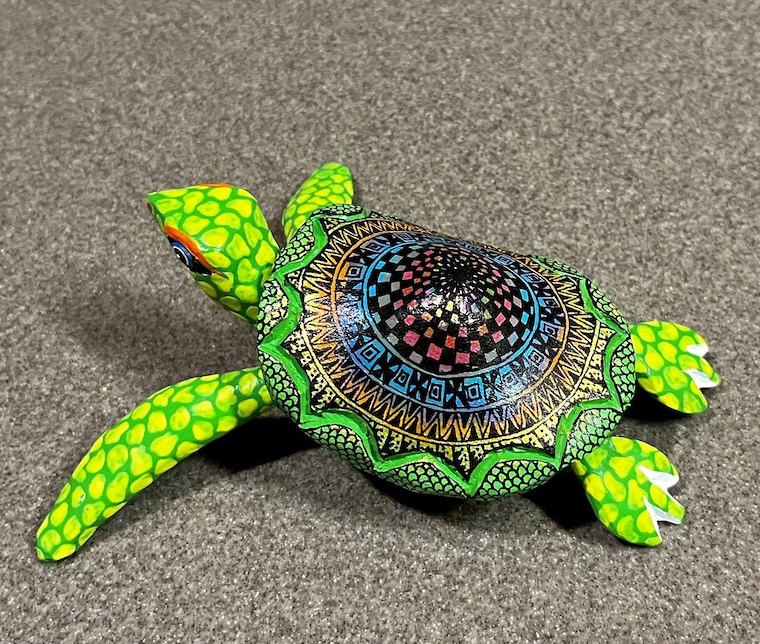PART 5 OF 5 PARTS
Not everyone agrees on which art form best exemplifies Oaxaca. But for me it’s alebrijes, those fantastical, intricately painted wooden figures often combining features of different critters. Some say they represent spirit guides.
 |
| Pedro Linares |
As much as I’d love to think the art form originated in Oaxaca with the pre-hispanic Zapotec or Mixtec cultures, the idea actually dates from the early 1940s and a Mexico City cartonero, or garbage collector, named Pedro Linares. The story goes that Linares, while in a fever-induced coma, dreamed he was in a magical forest, visited by surreal mash-ups of various animals. Some of them uttered a strange declaration: ¡Alebrije!
When he recovered he decided to give form to those visions, crafting the figures out of paper scraps and wheat glue.
Then Linares’s work was discovered and afforded some exposure by Diego Rivera and Frida Kahlo. But it was only decades later, in the 1980s, that Oaxacan artisans, already carving various figures out of Copal wood, saw Linares’s work at an exhibition and began adopting its whimsical interpretations and vivid coloration—and the name alebrijes. *
I’m determined to take home a nice alebrije as a souvenir of Oaxaca. So I’m especially aware as I pass the many shops and street stalls selling them. There’s obviously a wide range of quality—and prices. So when the opportunity to learn more about the art form presents itself I jump on it.
That Friday, skipping my usual morning Spanish class, I head to a village, about 20 miles southwest of the city, called Arrazola, one of the two places in Mexico best known for the quality of its alebrijes.
He induces chemical reactions...
to make one color dramatically
turn to
another.
A young man in one of the talleres, or workshops, leads me through a stunning gallery of the finished product and into the family’s sunny, wood-scented studio. There he shows me the whole production process, from selecting, curing and priming the protium copal wood, to dreaming up the designs, to making the super-bright paints.

He rubs these substances onto a rough sample shark figure, where the colors seem to materialize magically—even one combination that results in a surprisingly bright, pure white.
The muchacho explains how each critter they make represents the spirit essence of people born on a specific day of a specific year—even a specific time of day. In a tattered little book, he looks up my birthday and proclaims that my optimal spirit guide is the tortuga, a turtle.
While I realize this may be just a clever marketing pitch, I totally buy it and want to take home a really nice turtle. But even a small one, about the size of my hand, is priced at $5,000 pesos, or about $250, which I decide is a bit more than I want to spend.
 |
| My tortuga – made by a master |
And…he has a tortuga of the same size as the one I’d passed up in Arrazola. And it’s only $150 usd. Deal!
The bonus is I get to chat with the artist, who seems delighted that this tall, very white old man speaks his language. I always enjoy this kind of personal, heartfelt transaction. (Ironically, after getting to know Hedilberto, I’d gladly have paid him the same 5,000 pesos I’d denied the nameless kid in Arrazola.)
Ceramics
Spirit animals aren’t the only art form to celebrate in Oaxaca. There’s also the pottery. In Santa Maria Atzompa, I visit the workshop of a family that makes elaborate, brown terra cotta pieces—most of them decorative figurines bedecked in hundreds and hundreds of little ceramic flowers.
The woman who welcomes us is, I suspect, a member of the Blanco or Vásquez families, whose antecedents established their signature style and brought world-wide renown to their village. With her two-year-old daughter looking on, she takes a few lumps of clay, which is dark gray when wet, and demonstrates how to make a small figure—a sort of demonic man-beast-spirit amalgam with horns and a tail—and a few small flowers.
Textiles
The next of Oaxaca’s outstanding handcrafted arts that I’m able to glimpse this trip is its sumptuous textiles. Many shops and galleries display gorgeous bags, table runners and, certainly the best known of Oaxacan weavings, the tapetes, or woolen rugs, with their rich colors and distinctive Zapotec motifs. (Sally and I already have a beautiful tapete which we bought from a Oaxacan weaver in Zihuatanejo, Guerrero.)
Some of the shops even feature their own pedal looms, though I don’t get to see the weavers in action.

They range from the Mazatec style embroidery—from the northern part of the state bordering on Veracruz—with patterns of animals and flowers rendered on white cotton muslin skirts and blouses; to a slightly more refined gancho style—from the eastern Istmo region; to very fine, tightly-woven, muted-color wool ponchos and serapes—from Teotitlan del Valle.
Graphic Arts
 |
| Tlachiquero: one who extracts agave "honey" |
There are so many nice little galleries and workshops around Oaxaca’s historic center that it’s hard to walk a block without passing one. Alebrijes, pottery, textiles, and lots and lots of graphic art, which this former graphic designer especially appreciates.
I also wander into the elegant Graphic Arts Institute of Oaxaca, where an elegant young woman shows me around the exhibits, including some impressive old lithograph, etching and letterpress presses.
I decide not to spend a lot of time in the crowded print galleries, but I do manage to find a very nice, packable-size print, a composition of various Día de Muertos themes, at the El Pinche Grabador Gallery.
As with the other aspects of Oaxaca’s feast for the senses, I only have time for a few tastings of its art and handicrafts, and I’m leaving still hungry for more. Next time, I'll sample more: painting, basketry, black (barro negro) pottery, jewelry...
* Wikipedia






No comments:
Post a Comment